I have researched the problem and most sources say that moulds that thrive on moisture are a likely cause. Although our crawl space had some moderate moisture problems during the wet summer of 2005, it dried quickly and has been dry since then. In fact, it is very dry and quite dusty now. The smell was not evident during the moisture problem, but now seems to be a little stronger in the crawl space than the rest of the house.
I am including some details that might be helpful. The foundation is concrete with interior rigid foam insulation. We have HRV ventilation and an electric forced-air furnace. The crawl space floor has a vapour barrier with gravel under and sand on top. The sump is dry.
Any advice you have would be much appreciated.
-- Terry Dann, Gimli
ANSWER -- I agree with some of the results of your research in that the smell is likely moisture related. However, I would not necessarily jump to the conclusion that mould is what you smell, but that is a strong possibility. I also agree that the source of the smell is likely related to the crawl space, or subsoil components, but I will also offer other possibilities to explore.
It is true that when we smell a damp, musty odour in low-lying areas in our home the source is often mould. Unfortunately, the presence of moulds in our homes has been a reality forever but has become a bigger concern more recently due to our energy efficient construction methods. Most moulds are not dangerous to the majority of people, but efforts to minimize all environmental moulds in homes will usually benefit both the occupants and the structure.
My scepticism of excess mould being the source of your smell is due to your statement that your crawl space is dry and dusty. I routinely see some standing water and moulds in crawl spaces, even in relatively new homes, like yours. When there is no visible moisture, either in puddles or behind the polyethylene air-vapour barriers, there are usually no mould-related odours. Also, the presence of an HRV in your home should help prevent excessive moisture, if it is properly serviced and the controls used correctly. Therefore, the first thing to do is follow your initial instincts and explore the entire crawl space, with a good quality respirator for breathing protection. Look for rot or mould on any leftover construction debris, cardboard sono-tubes or void forms, or on the floor components in the crawl space. Look for water vapour and fungus underneath the poly on the gravel floor. Finally, look for the same behind the poly covering the insulation on the foundation walls. If the floor poly has not been extended over this area and the insulation is expanded (white) foam insulation, cut away a small section where the smell is strongest and look for moisture and mould on the concrete beneath. Finally, your description of the smell could also be the result of small animals, such as rodents, that have found a way into this area and died, so be on the lookout for that as well.
If this initial crawl space inspection does not yield any concrete results, more components in this area must be checked out. The next most likely culprits are either the weeping tile and sump pump system, or the plumbing drains. It is not unusual that your sump is dry in the middle of winter, when the ground outside is frozen solid, but if the sump is dry in the spring and summer, then there is likely a real problem. It is possible that the plastic drainage piping in the crawl space was not installed with sufficient slope to properly drain into the sump pit. It is also possible that the soil in the crawl space has heaved since initial construction of the foundation and the weeping tile has lost its original slope. If there is standing water in these plastic drainage pipes, it is likely the cause of the smell. You may be able to check this out by taking the cover off the sump pit and looking backwards through the holes in the pit with a mirror and flashlight.
If you open the sump pit and you don't see at least three to four drainage tile ends emptying into this area from different directions, there may be another oversight. The weeping tile may have been installed but never properly connected to the sump. This is usually readily apparent by a large pool of water around the sump pit, which may not be present if the pipes were temporarily blocked during construction to prevent plugging with debris. If this is suspected, you should be able to pull up a portion of the poly around the pit and dig around until you locate all the drainage pipes. Again, stagnant water in the plastic drainage pipes will certainly promote mould growth and a strong odour.
If none of these are the culprit and everything appears dry, the issue could be an open drain or a loose or missing cleanout cap in the ABS plumbing drains. This type of defect would certainly explain the noxious smell you have described. A plumber should be able to tell if this is the problem. If you still can't figure out the source, call the builder or a CAHPI home inspector to get a fresh set of knowledgeable eyes on the situation. Being in Gimli, right on the shores of the biggest body of water on the Prairies, the situation may simply be extremely high humidity in the crawl space. That would be a problem that can often be solved with proper use of your HRV or other ventilation in this area.
Ari Marantz is the owner of Trained Eye Home Inspection Ltd. and president of the Canadian Association of Home & Property Inspectors -- Manitoba (www.cahpi.mb.ca). Questions can be e-mailed or sent to: Ask The Inspector, P. O. Box 69021, #110-2025 Corydon Ave., Winnipeg, MB. R3P 2G9. Ari can be reached at (204) 291-5358 or check out his new website at www.trainedeye.ca
trainedeye@iname.com



